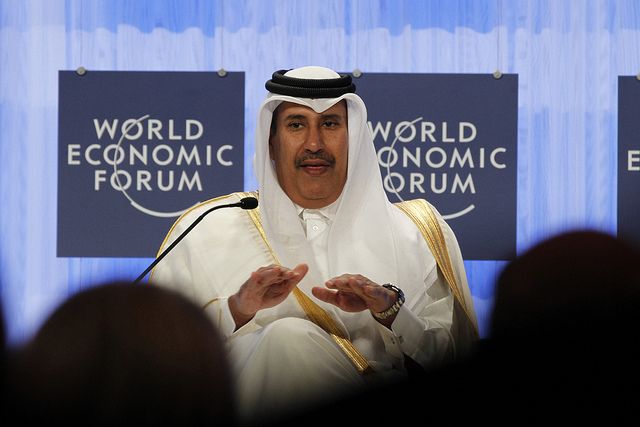
The flying visit of Prime Minister Hisham Qandil to Qatar on April 9 has apparently paid off. Today the Qatari Prime Minister Hamad bin Jassim Al Thani announced that Qatar would provide an additional $3 billion to Egypt, on top of the $5 billion that has been provided since the beginning of the Arab Spring in 2011.
In one sense this was not an unexpected outcome, even though as recently as March Finance Minister Youssef Kamal of Qatar stated that further financing for Egypt was not being considered. A very high-level Egyptian delegation, which press reports say that President Morsi himself was going to lead and then did not in the end, would not have travelled to Qatar, and that too in the middle of negotiations with the IMF for a program, had it not received some assurance that Qatari financing would be forthcoming. In fact, Governor Hisham Ramez of the Central Bank of Egypt had been in Doha for a three-day visit, presumably to lay the groundwork for the agreement. The precise form that this $3 billion will take is not yet clear. Qatar could buy Egyptian bonds or place the funds as a deposit in the Central Bank of Egypt. Either way it will add to Egypt’s foreign reserves in the first instance.
Furthermore, the Qatari prime minister also announced that Qatar would export liquefied natural gas (LNG) to Egypt to help ease the energy shortages the country was currently facing. While the terms of the LNG deal were not made public, it is likely that Qatar would offer LNG at reduced prices and/or a longer payment period.
What does this additional Qatari financing mean? There are basically two interpretations one can draw. The first, and one that has more support in the media and in the markets, is that the negotiations with the IMF are likely to be protracted and that agreement would not be reached until after parliamentary elections later this year. This despite the fact that the Egyptian Minister of Planning Al-Araby said on April 4 that agreement was imminent and would be reached by the end of the visit of the IMF team on April 15. To many observers the deadline of April 15 is now looking increasingly improbable and many good reasons are being advanced for this conclusion.
One of these reasons is that the IMF has misgivings about the economic plan the Egyptians have presented in support of a program. The concern has to be with the projected large size of the fiscal deficit of 9.5 percent of GDP in FY14 (July 2013-June 2014). This fiscal year the fiscal deficit is projected to be over 11 percent of GDP, so the adjustment next year would be nearly 2 percentage points of GDP. This is a substantial fiscal adjustment in one year and it is doubtful that the FJP and the Egyptian populous would have the stomach for this degree of austerity. If so, the fiscal deficit in FY14 could well turn out to be larger than 9.5 percent.
Another good reason is that the IMF has insisted in the past that the program should have broad political support. It is now clear that the opposition forces in Egypt are strongly against a program right now. Therefore, it is hard to believe that a program would be signed before parliamentary elections are held and a new elected government is installed. Once that happened, the condition of political consensus is no longer relevant. The IMF will negotiate and reach an agreement with an elected government whether or not the opposition is on board.
A second and more optimistic interpretation of the visit to Qatar is that the IMF program negotiations are on track and that the Qatari financing is part of the overall financing package. In all cases IMF staff has to ensure that the program is fully financed before it is taken to the IMF Executive Board for formal approval. As it stands now, the Egyptian balance of payments over the next fiscal year faces a shortfall of around $20 billion. This made up of some $13 billion in external debt servicing and a current account deficit of almost $7 billion. Assuming that half of the external debt can be rolled over, there remains a gap of some $13 billion. However, you have to add to this the increase in international reserves of $3 billion by June 2014 that was announced by the minister of planning on April 2. This means the gap that needs to be filled is $16 billion.
The new $3 billion from Qatar can then be treated as part of the overall financing package coming from the IMF, the World Bank, EU, and other multilaterals, plus financing from bilateral donors, including Libya, Iraq, and Saudi Arabia. The desire to reach the external financing target is perhaps the reason Minister of Planning Al-Araby reversed his earlier position of April 2 that Egypt will not request a larger IMF loan to stating today that it is very possible the amount could be increased beyond $4.8 billion.
Which of these two interpretations of the new Qatari financing is right? Of course, only time will tell. But, there are valid reasons why a further delay in finalizing the IMF program makes sense. It would allow the IMF to get the endorsement of the new elected government after parliamentary elections. It would give Egypt time to put together a financing package and delay implementing the needed fiscal austerity measures until after Ramadan and the summer. Until then, Egypt could muddle through with the financing it already has available to it. It’s going to be a hot summer with or without a program.
Photo: World Economic Forum
Image: Qatar_0.jpg
